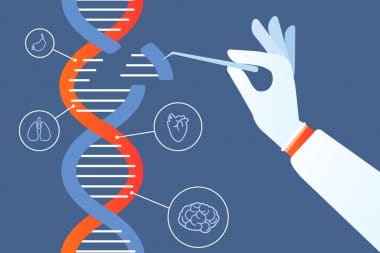Beckwith-wiedemann syndrome is an overgrowth, genetic disorder. It causes infants to be larger than normal. Growth will be accelerated during childhood, where the child will be larger than their peers. This syndrome is present at birth though it can be difficult to diagnose.Â
Beckwith-wiedemann syndrome occurs in one in every eleven thousand children. It is just as common in boys as it is in girls. Severity will differ between cases, and some will never even be diagnosed because symptoms will be so mild. Â
Symptoms
Infants born with Beckwith-wiedemann syndrome will be larger than normal when born. Sometimes growth will be asymmetric, where growth will be accelerated on one side of the body more so than the other.Â
Other main symptoms of Beckwith-wiedemann syndrome is organ and body overgrowth, enlarged tongue, too much insulin production, abdominal abnormalities, low blood sugar, and an increased cancer risk. Other symptoms can be higher risk of hernias, intestines or organs located outside of the body at birth, pits or creases on earlobes or behind the ears.
Symptoms can vary from case to case, as well as severity. Symptoms can sometimes be so mild that they aren’t even recognized or diagnosed.
Diagnosis
Diagnosing can be very difficult. Diagnosing Beckwith-wiedemann syndrome will start with medical history, and family history. If symptoms are present your doctor will want to do a physical exam, lab tests or even genetic testing. If you have had one child with Beckwith-wiedemann syndrome the risk of having another child with the syndrome is higher. Â
Treatment
There are a lot of treatment options. Treatment is usually directed toward specific symptoms, with mostly focusing on symptoms management. Some treatment choices are surgical procedures. Some surgical procedures could be done to help reduce tongue size, or surgical repair of the abdominal wall if organs were located outside of the body. After tongue reduction surgery the child may need to undergo speech therapy. Occupational therapy may also be needed in cases where a limb is longer than another.Â
Since children with Beckwith-wiedemann syndrome are at a higher risk for cancer there will need to be routine tumor screenings, and continuous monitoring to make sure no tumors occur. Treatments can also include monitoring of blood sugar, or IV treatments. Other screening from an oncologist will need to be done as well as scoliosis screenings to make sure the spine is aligned straight. Keeping up with treatment is important.
Outcomes
Children with Beckwith-wiedemann syndrome grow up to have a healthy normal lifespan. Though mortality is higher due to premature birth, hypoglycemia, macroglossia, or malignant tumors. The physical symptoms and the accelerated growth become less visible as the child gets older. Usually the growth rate slows down during the pre-teen and teen years. Children who have Beckwith-wiedemann syndrome can grow up and have normal lives, and even have children of their own.Â
Read More:Â Obesity & Genetics
ConclusionÂ
Beckwith-wiedemann syndrome is a rare overgrowth genetic disorder. It can cause some physical symptoms as well as some other overgrowth of organs. The syndrome is present at birth. Though it can cause a child to be larger than their peers, growth rate will slow down in pre-teen or teen years. The main concern and complication of Beckwith-wiedemann syndrome is the higher risk of cancer. Even if cancer isn’t present at birth, the child can still develop cancer overtime. Constant vigilance in checkups, and screenings will need to be done the child’s whole life.
Beckwith-Wiedemann Syndrome causes infants to be larger than normal. Though this syndrome can cause complications a normal lifespan is possible. Learn more here! #HealthStatus
The main concern and complication of Beckwith-wiedemann syndrome is the higher risk of cancer.
Sources:
https://rarediseases.org/rare-diseases/beckwith-wiedemann-syndrome/
https://www.chop.edu/conditions-diseases/beckwith-wiedemann-syndrome
https://rarediseases.info.nih.gov/diseases/3343/beckwith-wiedemann-syndrome
https://www.verywellhealth.com/beckwith-wiedemann-syndrome-overview-4178305

- Awarded Gold Seal by the Detox Project as a glyphosate detox solution
- Double-blind trial showed decrease in glyphosate by 74%
- Double-blind trial showed decrease in C-reactive protein by 75%








Reply